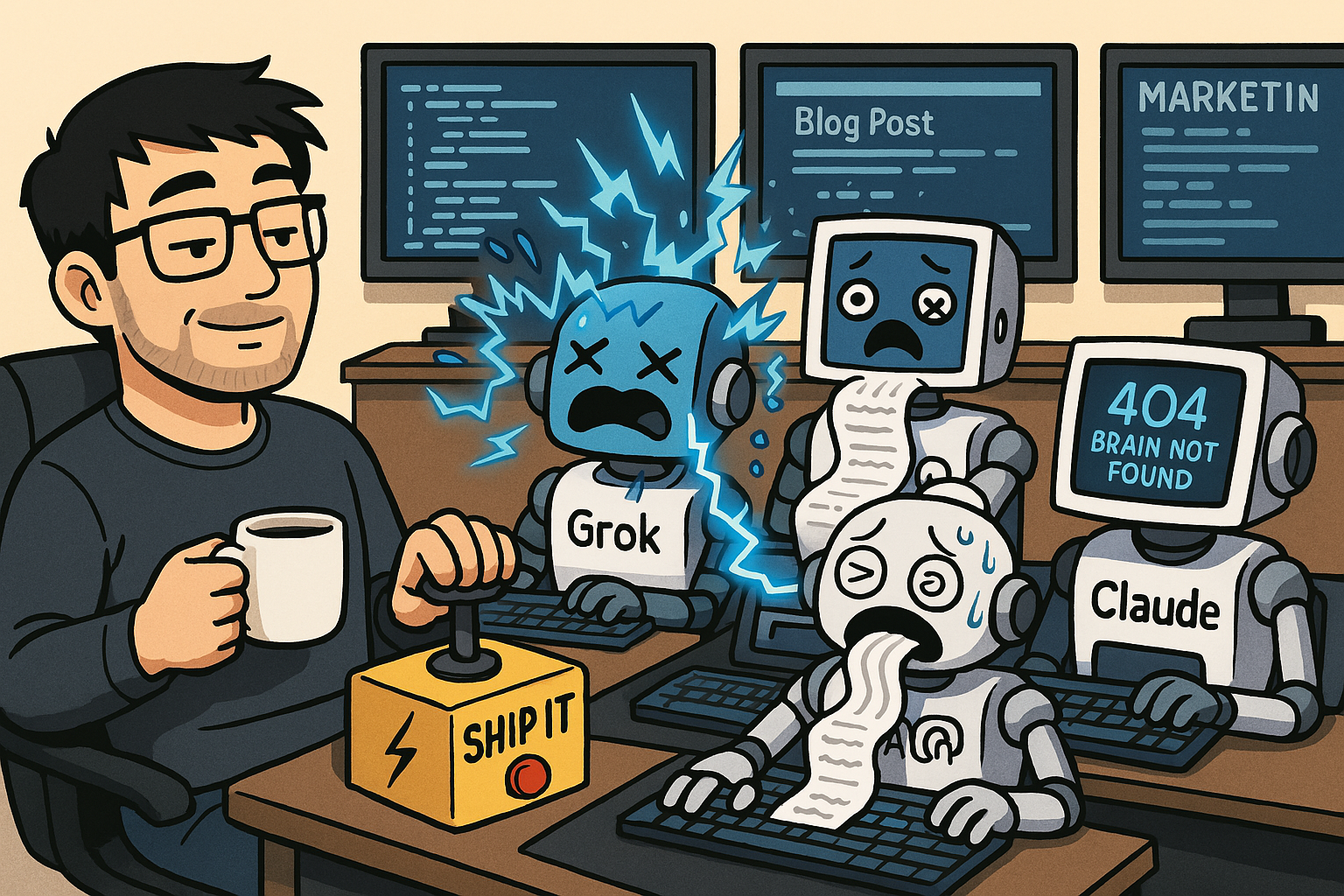There was a time when I wrote code. A simpler time. Fingers dancing on the keyboard, tabs overflowing, caffeine fueling the push to hit yet another deadline. But that era is gone. Today, my IDE (VSCode) is cold. My fingers? Untouched by semicolons.
Instead, I sit in my chair, sip my coffee, and stare at four blinking, jittery, overly helpful AI assistants: Gemini, Grok, ChatGPT, and Claude.
Each morning, I wake up, boot them up, and press the button. The button.
“SHIP IT ⚡️.”

Immediately, vibe coding with chaos erupts.
- Gemini starts writing perfect documentation for features that don’t exist.
- Claude begins philosophizing about user intent while writing your privacy policy.
- Grok is halfway through a stand-up comedy routine embedded in a JavaScript file.
- ChatGPT’s halfway done with a blog post, switching between Shakespeare and Buzzfeed tones mid-paragraph.
I nod.
"Good. Keep going."
The Tools I am using
I'm a PHP developer, and using PHPstorm, I do have a license but the AI features from Jetbrain requires an addition license, so I don't use it. Now I'm using VsCode with Copilot and I'm happy with it. I tried Cursor, Trae, Tabnine, they are all good, but I don't need them. I believe that in long term, big companies like Microsoft will win the AI battle (also give best pricing right now).
The new Copilot Agent is a game changer. Even it launched late than other competitors, but I'm happy to see its potential.
This is editors usage in my last 7 days 😆

The New Workflow
Here’s how my workday goes:
- Code? One AI handles that. It may hallucinate an entire framework, but hey, we’re shipping faster than ever.
- Blogs? Another AI is pumping out SEO-rich content while screaming internally in JSON.
- Marketing copy? I’ve got one AI pitching a product that doesn’t exist yet. No problem — we’ll build it later (maybe).
- Emails, documentation, tweets, site structure, even memes? Done.
All I do is coordinate the chaos. It’s like managing a team of hyper-talented, over-caffeinated interns — if the interns had 10,000 IQ and a tendency to occasionally invent new programming languages.
Why This Is Funny — And Also Kind of Real
Sure, the meme exaggerates. I’m not actually electrocuting my AI team (I think). But the core idea isn’t far from the truth: AI isn’t just a tool anymore — it’s a team.
We’re not just typing prompts for fun anymore. We’re entering the era of "vibe coding" — where the mood and energy of your prompts matter as much as the technical requirements. We’re building processes where multiple AIs specialize in different tasks — writing code, testing it, documenting it, packaging it, marketing it. Some devs are even building workflows where AI talks to AI, forming feedback loops that optimize without human input.
And in that world, the developer becomes something else. Not just a builder — but the conductor of a very weird orchestra, setting the vibe and directing the flow rather than writing every note.
But Let’s Be Honest...
Does it always work?
Absolutely not.
- Sometimes Gemini gaslights me into thinking I asked for Python when I clearly said JavaScript.
- ChatGPT will confidently cite RFCs that don’t exist.
- Claude goes on philosophical tangents that end with “...and thus, the user shall never be tracked again.”
- Grok... Grok does Grok things.
But that’s the beauty of it. Perfect isn't necessary. What's needed is speed, drafts, and raw ideas to sculpt. These chaotic AI gremlins deliver exactly that.
So Yeah — Not a Developer Anymore
The role has evolved into something else entirely.
A tamer of hallucinating robots. A caffeine-fueled conductor of creative chaos. A one-person startup powered by four confused AI brains and a very shiny red button.
Call it being the project manager of AI pain. And honestly? Productivity has never been higher.
Current Project: Skymage
Right now, the focus is Skymage Image CDN, a specialized CDN for transforming and optimizing images on the fly. Born from real-world pain points:
- Handling client's massive image libraries without server meltdowns
- Escaping framework lock-in that other solutions impose
- Creating truly dynamic image transformations without pre-defined rules
- Simplifying billing to just bandwidth usage (no complex calculations)
The initial version launched after a particularly frustrating client project involving 6MB images crashing a production site. After putting it aside for months, AI tools made it possible to return and rapidly improve the codebase, documentation, and marketing.
Sometimes the best products come from solving your own problems first.
Comments